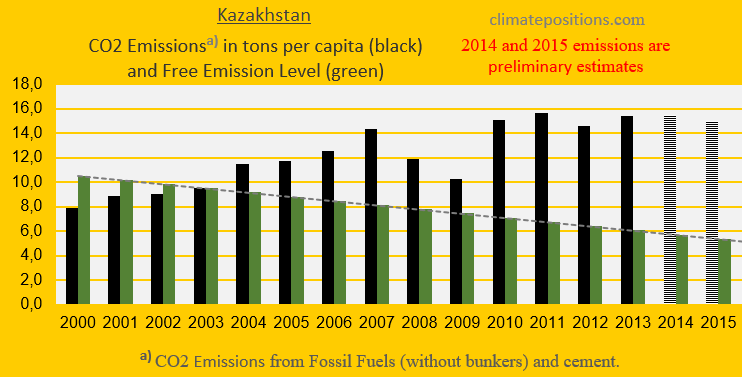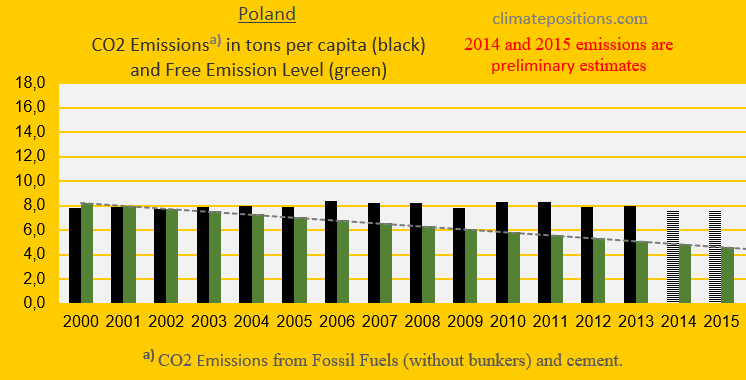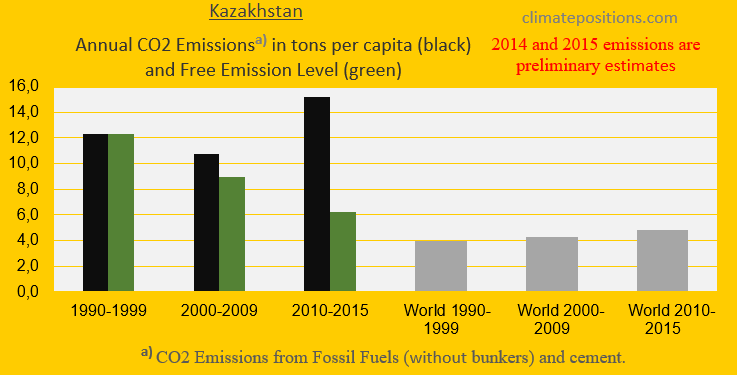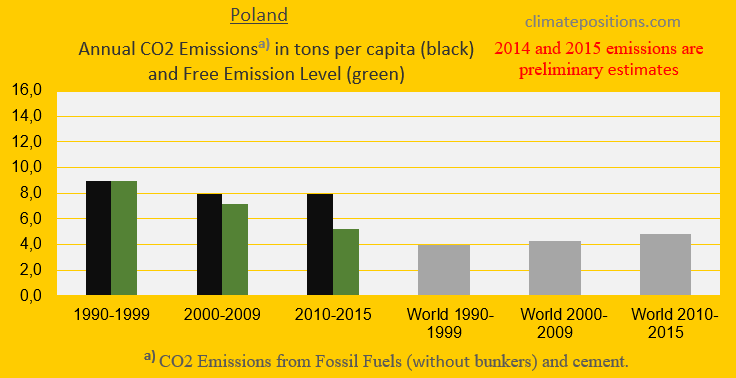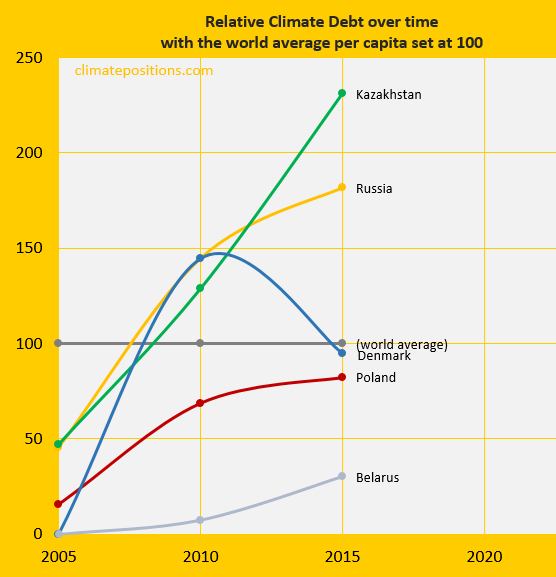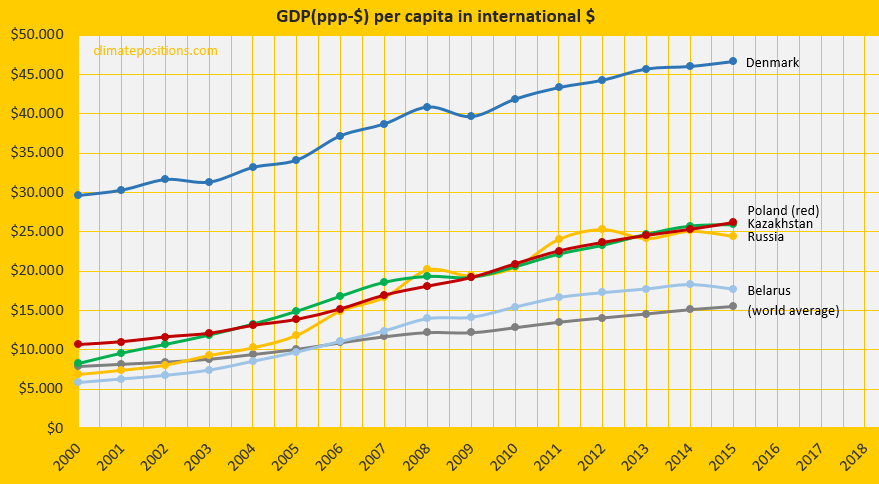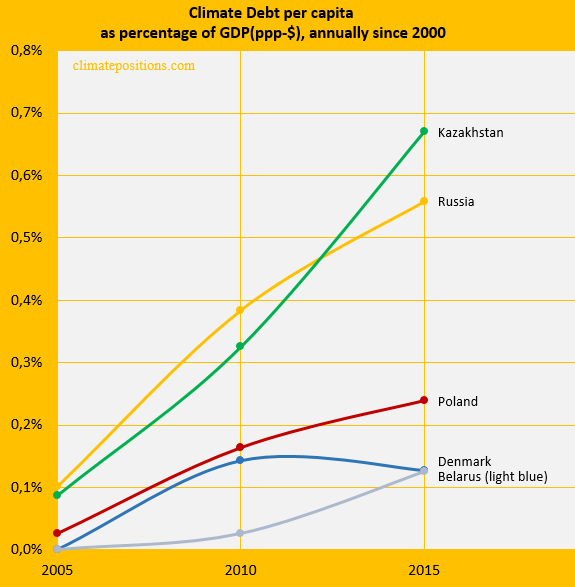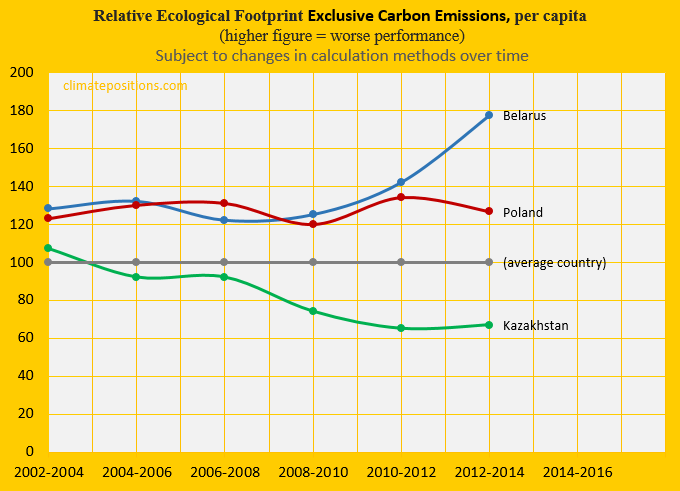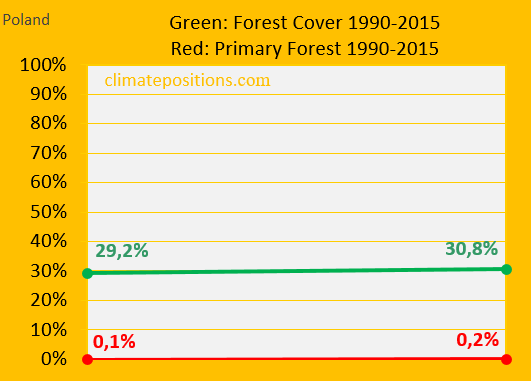Climate change performance: Kazakhstan vs. Poland
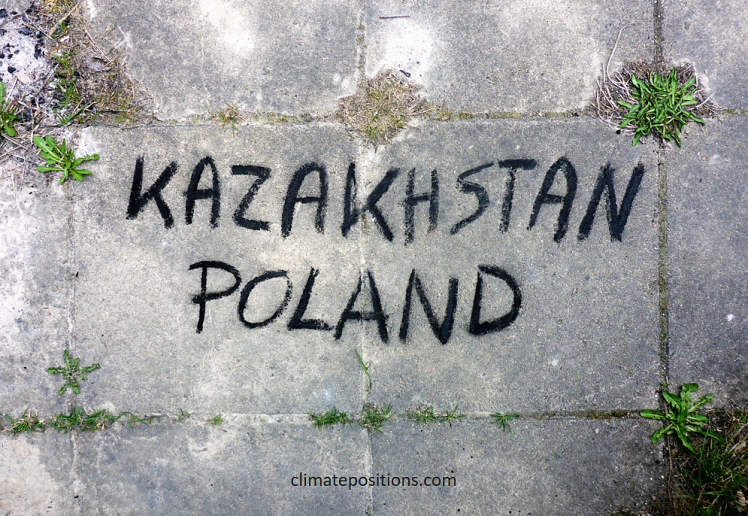
2017
In 2015 Kazakhstan and Poland were the world’s 2nd and 4th largest per capita coal producers. No wonder, the two countries, inhabited by 0.76% of the global population, emitted as much as 1.58% of the CO2 from Fossil Fuels (without bunkers) and cement.
The diagrams below show the per capita CO2 Emissions from Fossil Fuels (without bunkers) and cement, annually since 2000. The green bars show the Free Emission Level¹ – the exceedance is the basis for calculating the national Climate Debt.
The next two diagrams show Kazakhstan’s and Poland’s CO2 Emissions in tons per capita, in decades. The grey bars are world emissions average. In comparison with the average CO2 Emissions in the 1990s, Kazakhstan must reduce emissions by 67.6% by 2020, while Poland must reduce by 59.4%. The ‘Calculation methods‘ are identical for all 159 countries with full data in ClimatePositions.
The diagram below shows the relative per capita Climate Debt of Kazakhstan and Poland, in comparison with Russia, Belarus and Denmark – with the world’s average Climate Debt set at 100. Kazakhstan’s current per capita Climate Debt is $2,172 while Poland´s is $742 (see the latest ‘Ranking‘).
[Some figures in this article were corrected 22/5 2017]
The diagram below shows the per capita GDP(ppp-$) of the same five countries and the world average. The wealth of Kazakhstan and Poland is just about the same.
The next diagram shows Climate Debt of the five countries calculated as percentage of GDP(ppp-$), annually since 2000. See the opdated ‘Ranking‘.
The diagram below shows the relative per capita Ecological Footprint without the carbon footprint, of Kazakhstan, Poland and Belarus, with an average country set at 100. Poland’s footprint is nearly twice the one of Kazakhstan.
Poland’s Forest Cover has increased slightly since 1990, to 30.8% of the total area in 2015. However, the precious Primary Forests only cover 0.2% of the total area (or 0.6% of the Forest Cover). Furthermore, Poland just recently made a harmful change to environmental law that removed obligation for private landowners to apply for permission to cut down trees and pay compensation (read this ‘Article‘ from The Guardian). Last year Poland also sanctioned large-scale logging in the Białowieża forest, Europe’s last remaining primeval woodland (read these two article: ‘1‘ and ‘2‘). If Poland had increased Primary Forests to 20% of the Forest Cover, then the total Climate Debt would have been reduced by 31% ($9 billion reduction).
Kazakhstan’s Forest Cover is 1.2% of the total area and the Primary Forest is zero.
Finally, the table below shows four key values of the five countries, in the calculation of national Climate Debts in ClimatePositions. The price of CO2 per ton (column two) is for the total CO2 Emission from Fossil Fuels (without bunkers) and cement.
| . | Tons of CO2 | Price per | Climate change | Financing as |
| . | exceeded since | ton CO2 | financing | share of |
| . | 2000 per capita | since 2000 | per capita | Climate Debt |
| . | . | . | . | . |
| Kazakhstan | 71.51 | $10.93 | $0.00 | 0.00% |
| Poland | 24.58 | $5.82 | $0.00 | 0.00% |
| Russia | 54.80 | $8.86 | $0.01 | 0.00% |
| Denmark | 12.62 | $5.65 | $41.58 | 5.79% |
| Belarus | 14.84 | $3.23 | $0.00 | 0.00% |
.
¹The Free Emission Level (green bars) is determined by national CO2 Emissions 1990-1999 (base), and 11 more ‘Indicators‘, of which 7 are national and 4 are global.
.
Updated data and diagrams of all ‘Indicators‘ and all countries in ClimatePositions are available in the menu ‘Calculations (Excel)‘.
Data on carbon emissions (CO2 Emissions) from fossil fuels (without bunkers) and cement production are from Global Carbon Project (CDIAC); (links in the menu “Calculations”).
Information on national GDP(ppp-$) per capita: Worldbank (links in the menu “Calculations”).
Source on Ecological Footprint: Global Footprint Network (links in the menu “Calculations”).
Data on national Forest Cover and Primary Forests are from United Nations UN (Report: Global Forest Resources Assessments) (links in the menu “Calculations”).
Drawing (written with coal) by Claus Andersen, 2017.
Comments are closed.
